
Remarkable Rocks Panoramic Photo. It took 500 million years for rain, wind and surf to erode these rocks into their current form. They are a signature part of Flinders Chase National Park on Kangaroo Island, South Australia.
Location: Flinders Chase National Park, Kangaroo Island, South Australia
Image ID: 39224
Panorama dimensions: 200 x 674
Location: Flinders Chase National Park, Kangaroo Island, South Australia
Image ID: 39224
Panorama dimensions: 200 x 674

Cape du Couedic Lighthouse, Flinders Chase National Park, Kangaroo Island, South Australia.
Location: Flinders Chase National Park, Kangaroo Island, South Australia
Image ID: 39225
Location: Flinders Chase National Park, Kangaroo Island, South Australia
Image ID: 39225
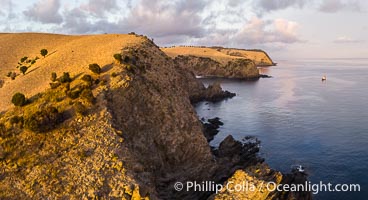
Sunrise on the North Coast of Kangaroo Island, near Western River, South Australia.
Location: Kangaroo Island, South Australia
Image ID: 39226
Location: Kangaroo Island, South Australia
Image ID: 39226

Bluethroat Wrasse, Notolabrus tetricus, Adult Male, Kangaroo Island, South Australia.
Species: Bluethroat Wrasse, Notolabrus tetricus
Location: Kangaroo Island, South Australia
Image ID: 39227
Species: Bluethroat Wrasse, Notolabrus tetricus
Location: Kangaroo Island, South Australia
Image ID: 39227

Aerial View of Kangaroo Island North Coast, near Cape Torrens, South Australia.
Location: Kangaroo Island, South Australia
Image ID: 39228
Location: Kangaroo Island, South Australia
Image ID: 39228

Unidentified Soft Corals, Wreck of the Portland Maru, Kangaroo Island, South Australia. The Portland Maru was a 117-meter Japanese cargo ship which struck a submerged object and was beached near Cape Borda, Kangaroo Island, on March 19, 1935.
Location: Wreck of the Portland Maru, Kangaroo Island, South Australia
Image ID: 39229
Location: Wreck of the Portland Maru, Kangaroo Island, South Australia
Image ID: 39229

Old Wife fishes schooling on the Wreck of the Portland Maru, Enoplosus armatus. The Portland Maru was a 117-meter Japanese cargo ship which struck a submerged object and was beached near Cape Borda, Kangaroo Island, on March 19, 1935.
Species: Old wife, Enoplosus armatus
Location: Wreck of the Portland Maru, Kangaroo Island, South Australia
Image ID: 39230
Species: Old wife, Enoplosus armatus
Location: Wreck of the Portland Maru, Kangaroo Island, South Australia
Image ID: 39230

Common Bullseye, Pempheris multiradiata, on the wreck of the Portland Maru, Kangaroo Island, South Australia. The Portland Maru was a 117-meter Japanese cargo ship which struck a submerged object and was beached near Cape Borda, Kangaroo Island, on March 19, 1935.
Species: Common Bullseye, Pempheris multiradiata
Location: Wreck of the Portland Maru, Kangaroo Island, South Australia
Image ID: 39231
Species: Common Bullseye, Pempheris multiradiata
Location: Wreck of the Portland Maru, Kangaroo Island, South Australia
Image ID: 39231
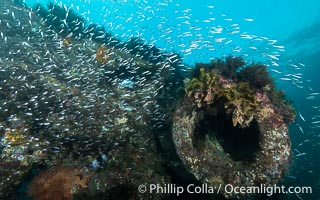
Yellowhead Hulafish, Trachinops noarlungae, schooling on the wreck of the Portland Maru, Kangaroo Island, South Australia. The Portland Maru was a 117-meter Japanese cargo ship which struck a submerged object and was beached near Cape Borda, Kangaroo Island, on March 19, 1935.
Species: Yellowhead Hulafish, Trachinops noarlungae
Location: Wreck of the Portland Maru, Kangaroo Island, South Australia
Image ID: 39232
Species: Yellowhead Hulafish, Trachinops noarlungae
Location: Wreck of the Portland Maru, Kangaroo Island, South Australia
Image ID: 39232
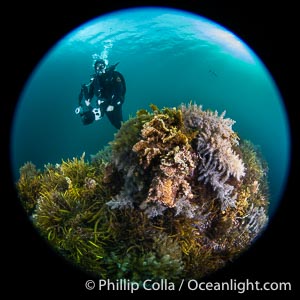
SCUBA Diver Underwater hovering over the Wreck of the Portland Maru at Kangaroo Island, South Australia.
Location: Wreck of the Portland Maru, Kangaroo Island, South Australia
Image ID: 39234
Location: Wreck of the Portland Maru, Kangaroo Island, South Australia
Image ID: 39234

Old Wife fishes schooling on the Wreck of the Portland Maru, Enoplosus armatus. The Portland Maru was a 117-meter Japanese cargo ship which struck a submerged object and was beached near Cape Borda, Kangaroo Island, on March 19, 1935.
Species: Old wife, Enoplosus armatus
Location: Wreck of the Portland Maru, Kangaroo Island, South Australia
Image ID: 39235
Species: Old wife, Enoplosus armatus
Location: Wreck of the Portland Maru, Kangaroo Island, South Australia
Image ID: 39235

Boat M/V Rodney Fox at Rapid Bay Jetty, South Australia.
Location: Rapid Bay Jetty, South Australia
Image ID: 39358
Location: Rapid Bay Jetty, South Australia
Image ID: 39358

Blade Runner, the injured North Pacific humpback whale, is seen with her calf swimming alongside. This humpback whale showing extensive scarring, almost certainly from a boat propeller, on dorsal ridge. This female North Pacific humpback whale was first seen with the depicted lacerations near the island of Maui in the Hawaiian Islands in the mid-90s, and is the original humpback to bear the name 'Blade Runner'. This female has apparently recovered, as evidenced by her calf in the background. A South Pacific humpback whale endured a similar injury in Sydney Australia in 2001, and bears a remarkably similar scar pattern to the above-pictured whale.
Species: Humpback whale, Megaptera novaeangliae
Location: Maui, Hawaii
Image ID: 05907
Species: Humpback whale, Megaptera novaeangliae
Location: Maui, Hawaii
Image ID: 05907

The leafy seadragon (Phycodurus eques) is found on the southern and western coasts of Australia. Its extravagent appendages serve only for camoflage, since it has a nearly-invisible dorsal fin that propels it slowly through the water. The leafy sea dragon is the marine emblem of South Australia.
Species: Leafy seadragon, Phycodurus eques
Location: Rapid Bay Jetty, South Australia
Image ID: 39133
Species: Leafy seadragon, Phycodurus eques
Location: Rapid Bay Jetty, South Australia
Image ID: 39133

The leafy seadragon (Phycodurus eques) is found on the southern and western coasts of Australia. Its extravagent appendages serve only for camoflage, since it has a nearly-invisible dorsal fin that propels it slowly through the water. The leafy sea dragon is the marine emblem of South Australia.
Species: Leafy seadragon, Phycodurus eques
Location: Rapid Bay Jetty, South Australia
Image ID: 39136
Species: Leafy seadragon, Phycodurus eques
Location: Rapid Bay Jetty, South Australia
Image ID: 39136

Great White Shark, South Neptune Islands, South Australia.
Species: Great white shark, Carcharodon carcharias
Location: South Neptune Islands, South Australia
Image ID: 39151
Species: Great white shark, Carcharodon carcharias
Location: South Neptune Islands, South Australia
Image ID: 39151
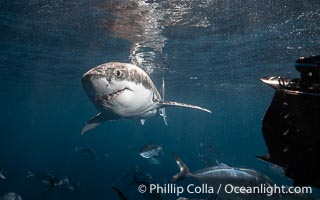
Great White Shark, South Neptune Islands, South Australia.
Species: Great white shark, Carcharodon carcharias
Location: South Neptune Islands, South Australia
Image ID: 39152
Species: Great white shark, Carcharodon carcharias
Location: South Neptune Islands, South Australia
Image ID: 39152

Great White Shark, South Neptune Islands, South Australia.
Species: Great white shark, Carcharodon carcharias
Location: South Neptune Islands, South Australia
Image ID: 39153
Species: Great white shark, Carcharodon carcharias
Location: South Neptune Islands, South Australia
Image ID: 39153

Great White Shark, South Neptune Islands, South Australia.
Species: Great white shark, Carcharodon carcharias
Location: South Neptune Islands, South Australia
Image ID: 39154
Species: Great white shark, Carcharodon carcharias
Location: South Neptune Islands, South Australia
Image ID: 39154

Australian Sea Lion Underwater, Grindal Island. Australian sea lions are the only endemic pinniped in Australia, and are found along the coastlines and islands of south and west Australia.
Species: Australian Sea Lion, Neophoca cinearea
Location: Grindal Island, South Australia
Image ID: 39176
Species: Australian Sea Lion, Neophoca cinearea
Location: Grindal Island, South Australia
Image ID: 39176

Australian Sea Lions in Kelp, Grindal Island. Australian sea lions are the only endemic pinniped in Australia, and are found along the coastlines and islands of south and west Australia.
Species: Australian Sea Lion, Neophoca cinearea
Location: Grindal Island, South Australia
Image ID: 39177
Species: Australian Sea Lion, Neophoca cinearea
Location: Grindal Island, South Australia
Image ID: 39177

Australian Sea Lions in Kelp, Grindal Island. Australian sea lions are the only endemic pinniped in Australia, and are found along the coastlines and islands of south and west Australia.
Species: Australian Sea Lion, Neophoca cinearea
Location: Grindal Island, South Australia
Image ID: 39178
Species: Australian Sea Lion, Neophoca cinearea
Location: Grindal Island, South Australia
Image ID: 39178

Australian Sea Lion Underwater, Grindal Island. Australian sea lions are the only endemic pinniped in Australia, and are found along the coastlines and islands of south and west Australia.
Species: Australian Sea Lion, Neophoca cinearea
Location: Grindal Island, South Australia
Image ID: 39179
Species: Australian Sea Lion, Neophoca cinearea
Location: Grindal Island, South Australia
Image ID: 39179

Australian Sea Lions in Kelp, Grindal Island. Australian sea lions are the only endemic pinniped in Australia, and are found along the coastlines and islands of south and west Australia.
Species: Australian Sea Lion, Neophoca cinearea
Location: Grindal Island, South Australia
Image ID: 39180
Species: Australian Sea Lion, Neophoca cinearea
Location: Grindal Island, South Australia
Image ID: 39180

Australian Sea Lion Underwater, Grindal Island. Australian sea lions are the only endemic pinniped in Australia, and are found along the coastlines and islands of south and west Australia.
Species: Australian Sea Lion, Neophoca cinearea
Location: Grindal Island, South Australia
Image ID: 39181
Species: Australian Sea Lion, Neophoca cinearea
Location: Grindal Island, South Australia
Image ID: 39181
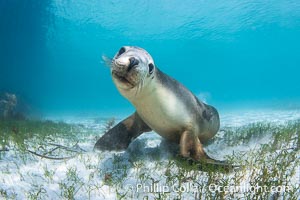
Australian Sea Lion Underwater, Grindal Island. Australian sea lions are the only endemic pinniped in Australia, and are found along the coastlines and islands of south and west Australia.
Species: Australian Sea Lion, Neophoca cinearea
Location: Grindal Island, South Australia
Image ID: 39182
Species: Australian Sea Lion, Neophoca cinearea
Location: Grindal Island, South Australia
Image ID: 39182

Australian Sea Lion Underwater, Grindal Island. Australian sea lions are the only endemic pinniped in Australia, and are found along the coastlines and islands of south and west Australia.
Species: Australian Sea Lion, Neophoca cinearea
Location: Grindal Island, South Australia
Image ID: 39183
Species: Australian Sea Lion, Neophoca cinearea
Location: Grindal Island, South Australia
Image ID: 39183
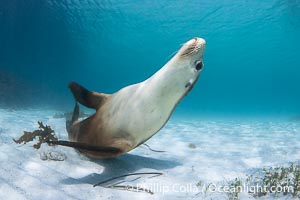
Australian Sea Lion Underwater, Grindal Island. Australian sea lions are the only endemic pinniped in Australia, and are found along the coastlines and islands of south and west Australia.
Species: Australian Sea Lion, Neophoca cinearea
Location: Grindal Island, South Australia
Image ID: 39184
Species: Australian Sea Lion, Neophoca cinearea
Location: Grindal Island, South Australia
Image ID: 39184

Australian Sea Lion Underwater, Grindal Island. Australian sea lions are the only endemic pinniped in Australia, and are found along the coastlines and islands of south and west Australia.
Species: Australian Sea Lion, Neophoca cinearea
Location: Grindal Island, South Australia
Image ID: 39185
Species: Australian Sea Lion, Neophoca cinearea
Location: Grindal Island, South Australia
Image ID: 39185

Australian Sea Lion Underwater, Grindal Island. Australian sea lions are the only endemic pinniped in Australia, and are found along the coastlines and islands of south and west Australia.
Species: Australian Sea Lion, Neophoca cinearea
Location: Grindal Island, South Australia
Image ID: 39186
Species: Australian Sea Lion, Neophoca cinearea
Location: Grindal Island, South Australia
Image ID: 39186